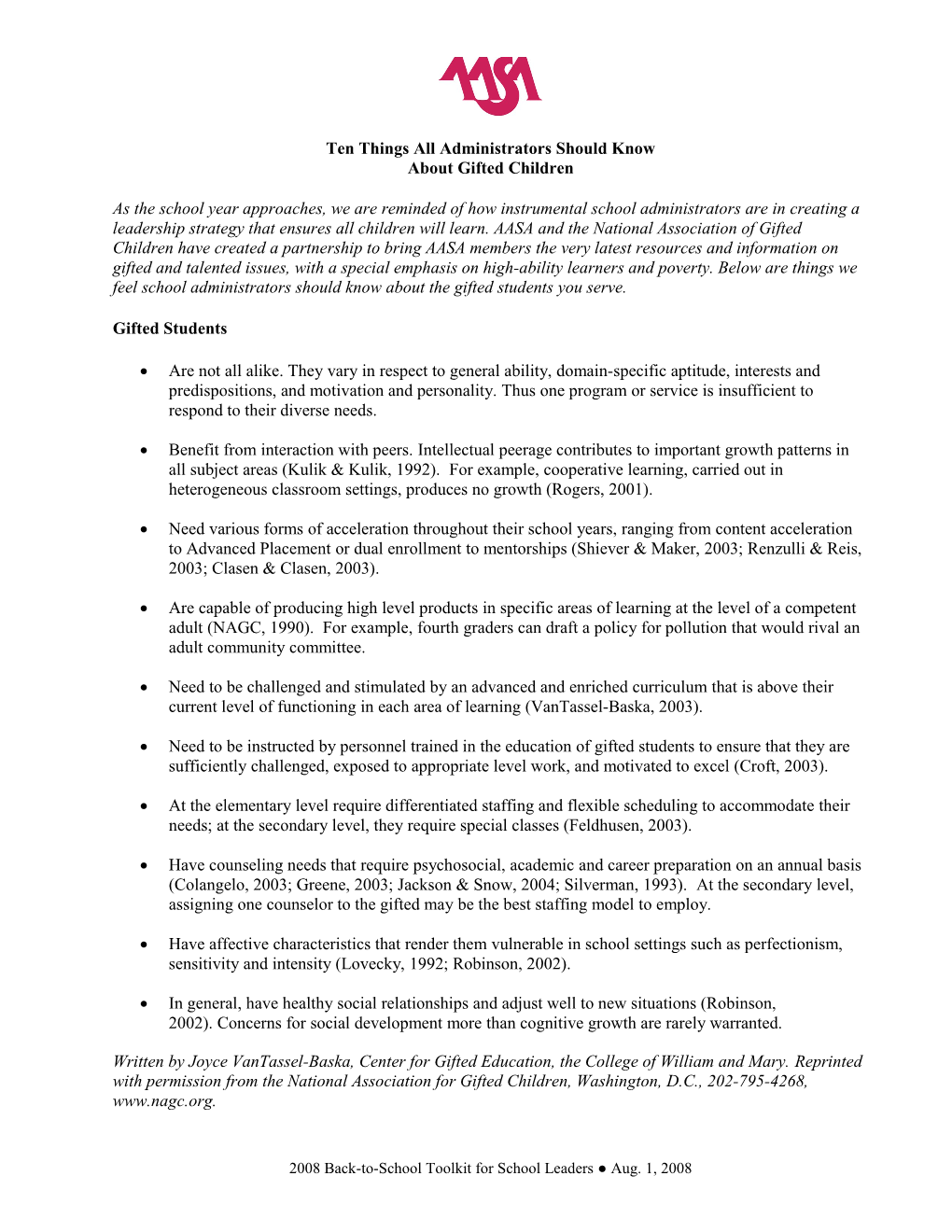Ten Things All Administrators Should Know
About Gifted Children
As the school year approaches, we are reminded of how instrumental school administrators are in creating a leadership strategy that ensures all children will learn. AASA and the National Association of Gifted Children have created a partnership to bring AASA members the very latest resources and information on gifted and talented issues, with a special emphasis on high-ability learners and poverty. Below are things we feel school administrators should know about the gifted students you serve.
Gifted Students
- Are not all alike. They vary in respect to general ability, domain-specific aptitude, interests and predispositions, and motivation and personality. Thus one program or service is insufficient to respond to their diverse needs.
- Benefit from interaction with peers. Intellectual peerage contributes to important growth patterns in all subject areas (Kulik & Kulik, 1992). For example, cooperative learning, carried out in heterogeneous classroom settings, produces no growth (Rogers, 2001).
- Need various forms of acceleration throughout their school years, ranging from content acceleration to Advanced Placement or dual enrollment to mentorships (Shiever & Maker, 2003; Renzulli & Reis, 2003; Clasen & Clasen, 2003).
- Are capable of producing high level products in specific areas of learning at the level of a competent adult (NAGC, 1990). For example, fourth graders can draft a policy for pollution that would rival an adult community committee.
- Need to be challenged and stimulated by an advanced and enriched curriculum that is above their current level of functioning in each area of learning (VanTassel-Baska, 2003).
- Need to be instructed by personnel trained in the education of gifted students to ensure that they are sufficiently challenged, exposed to appropriate level work, and motivated to excel (Croft, 2003).
- At the elementary level require differentiated staffing and flexible scheduling to accommodate their needs; at the secondary level, they require special classes (Feldhusen, 2003).
- Have counseling needs that require psychosocial, academic and career preparation on an annual basis (Colangelo, 2003; Greene, 2003; Jackson & Snow, 2004; Silverman, 1993). At the secondary level, assigning one counselor to the gifted may be the best staffing model to employ.
- Have affective characteristics that render them vulnerable in school settings such as perfectionism, sensitivity and intensity (Lovecky, 1992; Robinson, 2002).
- In general, have healthy social relationships and adjust well to new situations (Robinson, 2002). Concerns for social development more than cognitive growth are rarely warranted.
Written by Joyce VanTassel-Baska, Center for Gifted Education, the College of William and Mary. Reprinted with permission from the National Association for Gifted Children, Washington, D.C., 202-795-4268,
References
Clasen, D. R., & Clasen, R. E. (2003). Mentoring the gifted and talented. In N. Colangelo & G. A. Davis (Eds.), Handbook of gifted education (3rd ed., pp. 254-267). Boston: Allyn & Bacon.
Colangelo, N. & Davis, G. (Eds.) (2003). Handbook of gifted education. (3rd ed). MA: Allyn & Bacon.
Croft, L. J. (2003). Teachers of the gifted: Gifted teachers. In N. Colangelo & G. Davis (Eds.), Handbook of gifted education (3rd ed., pp. 558-571). Boston, MA: Allyn & Bacon.
Feldhusen, J.F. (2003). Precocity and acceleration. Gifted Education International, 17(1), 55-58.
Greene, M. (2003). Gifted adrift? Career counseling of the gifted and talented. Roeper Review, 25, 66-72.
Jackson & Snow. (2004). Counseling Gifted Students and their Families. In Boothe, D., & Stanley, J. C. (Eds.). In the eyes of the beholder: Critical issues for diversity in gifted education. (Chapter 14). Waco, TX: Prufrock Press.
Kulik, J. A., & Kulik, C.C. (1992). Meta-analytic findings on grouping programs. Gifted Child Quarterly, 36, 73-77.
Lovecky, D. V. (1992). Exploring social and emotional aspects of giftedness in
children. Roeper Review, 15, 18-25.
Maker, C. J., & Schiever, S. W. (2005). Teaching models in education of the gifted (3rd ed.). Austin, TX: PRO-ED.
Renzulli, J. S., & Reis, S. M. (2003). The schoolwide enrichment model: Developing creative and productive giftedness. In N. Colangelo, & G.A. Davis (Eds.) Handbook of gifted education (3rd ed., pp.184-203). Boston, MA: Allyn & Bacon.
Robinson, N. M. (2002). Assessing and advocating for gifted students: Perspectives for school and clinical psychologists. Senior scholars series. Storrs, CT: National Research Center on the Gifted and Talented, University of Connecticut.
Rogers, K. B. (2001). Re-Forming gifted education: How parents and teachers can match the program to the child. Scottsdale, AZ: Great Potential Press.
Silverman, L. K. (Ed.). (1993). Counseling the gifted and talented. Denver: Love Publishing Company.
VanTassel-Baska, J. (2003). Curriculum planning and instructional design for gifted learners. Denver, CO: Love Publishing.
2008 Back-to-School Toolkit for School Leaders ● Aug. 1, 2008
